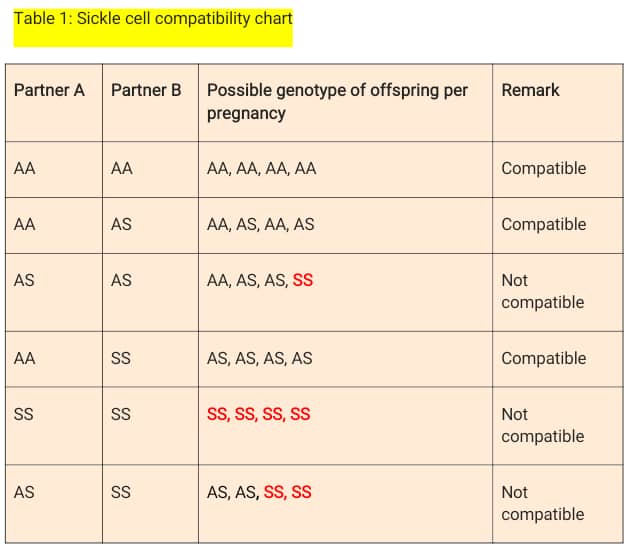Play your part; let’s “flatten the curve” of Sickle Cell Disease in Sub-saharan Africa.Sickle Cell Disease is a group of inherited red blood cell disorders. It occurs when a person inherits two sickle cell haemoglobin genes, one from each parent with one of the genes being ‘S’ gene (Table 1). It is detected by a simple genotype test and the types include SS (the most severe type), SC, SE, S thalassaemia e.t.c. The normal red blood cells (with AA haemoglobin) are flexible and disk-shaped, and they move through small blood vessels easily carrying oxygen to all parts of the body. However, red blood cells in persons with SCD are rigid and sticky reminiscent of the C-shaped farm tool “sickle”. Consequently, they get stuck and block blood flow giving rise to the painful crisis. The sickle cells also have a short life span leading to constantly low red blood cells (anaemia).
Sub-saharan Africa bears the greatest burden of SCD globally with over 300,000 babies delivered with the disease annually, largely in Nigeria and the Democratic Republic of Congo. Unfortunately, this figure is expected to rise to 400,000 by 2050 given the current level of prevention. In Nigeria alone, about 150,000 newborns with SCD are delivered annually and the disease affects about 3 per cent of the population (i.e., approximately 6 million persons). Additionally, the carriers of the disease i.e., those with sickle cell trait (possessing only one sickle cell gene) are between 10 and 30 per cent of the estimated 200 million Nigerians, which translates to between 20 to 60 million persons with the traits.
Signs of the disease often begin during the first year of life; usually around the sixth month with the disease manifestation varying from mild to severe among affected persons. Occlusion of blood vessels manifesting as a painful crisis, stroke, and acute chest syndrome e.t.c is a major cause of hospital admissions and death. Sufferers are also predisposed to recurrent infections especially, from bacterial organisms. Childhood death attributed to SCD varies from 50 to 90 per cent in Africa, with only about half of the affected children reaching their fifth birthday. Those who survived have to contend various medical and psychosocial problems such as negative stereotypes, discrimination, stigmatization and even suicide. Although individuals with sickle cell traits do not have the manifestations of the disease, they are the reservoir of the disease because there is 25 per cent chance of having a baby with SCD per pregnancy if both couples have the trait (Table 1).

Given the agony persons with SCD experiences, we must take collective responsibility towards reducing the burden of the disease as well as making quality care accessible to affected individuals. Mass awareness of the disease and how it’s inherited will be crucial and it is anticipated that the readers of this article are better informed and could join the advocacy. Media outfits (electronic and print), religious institutions and social media influencers should prioritize creating awareness of the disease, not just on the designated day of the year but periodically. All individuals should be encouraged to know their genotype and can take the right decision on compatible life partners (Table 1). It is also important that discussions about compatibility come on at the earliest stage of relationships to avoid taking risky decisions that are not in the best interest of the unborn child out of overwhelming emotion. The government also has a huge role to play in leading mass advocacy and in the establishment of a national newborn screening program which is the ideal to identify affected individuals before the development of complications. Early identification of affected persons should be complemented by improving the quality and coverage of existing health care services. Sickle cell disease is a lifelong disorder with attendant economic implications on the affected individuals and its family, it is therefore imperative for the government at all levels to widen the scope of health insurance to accommodate the vast majority that is currently uncovered. Health institutions, especially the public-owned can also cushion the economic burden of care for the affected individuals by offering subsidized care or offering treatment waivers especially in the areas of provision of recommended vaccines, medications and blood transfusion services.
This Column on Sickle Cell Awareness is a credit to Dr. Taofiq Ogunkunle, a Consultant Paediatrician.



